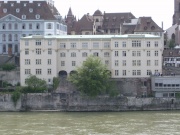Minuscule 2
From Textus Receptus
Minuscule 2 (in the Gregory-Aland numbering), ε 1214 (Von Soden). It is a Greek minuscule manuscript of the New Testament, dated paleographically to the 11th or 12th century. It was used by Erasmus in his edition of Greek text of the New Testament and became the basis for what is called the Textus Receptus in the Gospels.
Contents |
Description
The codex contains a complete text of the four Gospels on 248 parchment leaves with size 19.5 by 15.2 cm (text only 13.6 by 9.9 cm). It is written in 1 column per page, 20 lines per page, in minuscule letters. The text is not very good and has numerous errors. It contains tables of κεφαλαια (before every Gospel), κεφαλαια (not in John), τιτλοι, the Ammonian Sections, and subscriptions. The Eusebian Canons is absent. Some leaves were lost, but the text survived in complete condition.
Matthew is divided into 359, Mark - 240, Luke - 342, and John into 231 Ammonian Sections (common accepted Ammonian Sections: 355, 235, 343, 232).
Text
The Greek text of the codex is a representative of the Byzantine text-type. Aland placed it in Category V.
In John 8:6 it used textual variant μη προσποιουμενος, erased by corrector. Τhis variant have also the manuscripts 07, 011, 017, 028, 041, and majority of the Byzantine manuscripts. It is not included by the manuscripts 021, 028, 030, 036, 045, 047, 7, 8, 9, 461c2, 1203, 1216, 1243, 1514, 196, ℓ 663. Erasmus did not use this phrase in his Novum Testamentum.
History of the codex
The codex was bought by monks at Basle for two Rhenish florins. Since 1559 it was held in the University of Basel. Its later story is the same as that of Codex Basilensis and Minuscule 1.
Desiderius Erasmus received this codex from the dominican monks at the Basel, 6 and chiefly used as the basis for the first edition of his Novum Testamentum (1516), with press corrections by his hand, and barbarously scored with red chalk to suit his pages. Robert Estienne did not use this manuscript in his Editio Regia (1550), but based on Erasmian text. In result its readings became a basis for the Textus Receptus.
Martin Crusius used this manuscript in 1577. [7] The manuscript was examined by Bengel, Wettstein, Burgon, Hoskier, Gregory.
It was cited in 27 edition of Nestle-Aland Novum Testamentum Graece only once (1 Cor 11:23). [8] The codex is located now at the University of Basel (A.N. IV. 1) at Basel.[1]
See also
References
- 1. K. Aland, M. Welte, B. Köster, K. Junack, Kurzgefasste Liste der griechischen Handschriften des Neues Testaments, Walter de Gruyter, Berlin, New York 1994, p. 47.
- 2. C. R. Gregory, "Textkritik des Neuen Testaments", Leipzig 1900, vol. 1, p. 127-128.
- 3. Kurt Aland, and Barbara Aland, "The Text of the New Testament: An Introduction to the Critical Editions and to the Theory and Practice of Modern Textual Criticism", transl. Erroll F. Rhodes, William B. Eerdmans Publishing Company, Grand Rapids, Michigan, 1995, p. 138.
- 4. The Gospel According to John in the Byzantine Tradition (Deutsche Bibelgesellschaft: Stuttgart, 2007), p. 100.
- 5. Scrivener, Frederick Henry Ambrose (1894). A Plain Introduction to the Criticism of the New Testament, Vol. 1. London: George Bell & Sons. p. 191.
- 6. W. W. Combs, Erasmus and the textus receptus, DBSJ 1 (Spring 1996), 45.
- 7. Kurt Aland, "Synopsis Quattuor Evangeliorum. Locis parallelis evangeliorum apocryphorum et patrum adhibitis edidit", Deutsche Bibelgesellschaft, Stuttgart 1996, p. XXVII.
Further reagings
- C. C. Tarelli, Erasmus’s Manuscripts of the Gospels, JTS XLIV (1943), 155-162.
- K. W. Clark, Observations on the Erasmian Notes in Codex 2, in Studia Evangelica, ed. F.L. Cross, K. Aland, et al., T & U 73 (Berlin 1959), pp. 749-756.

